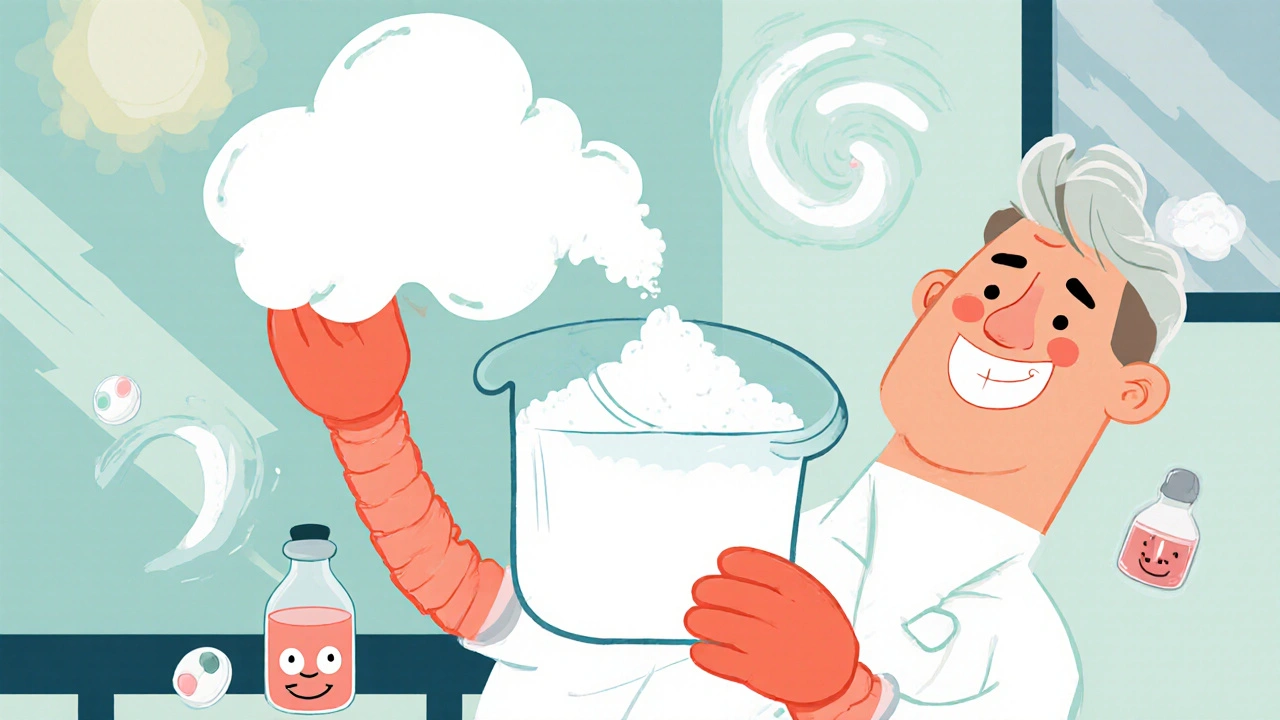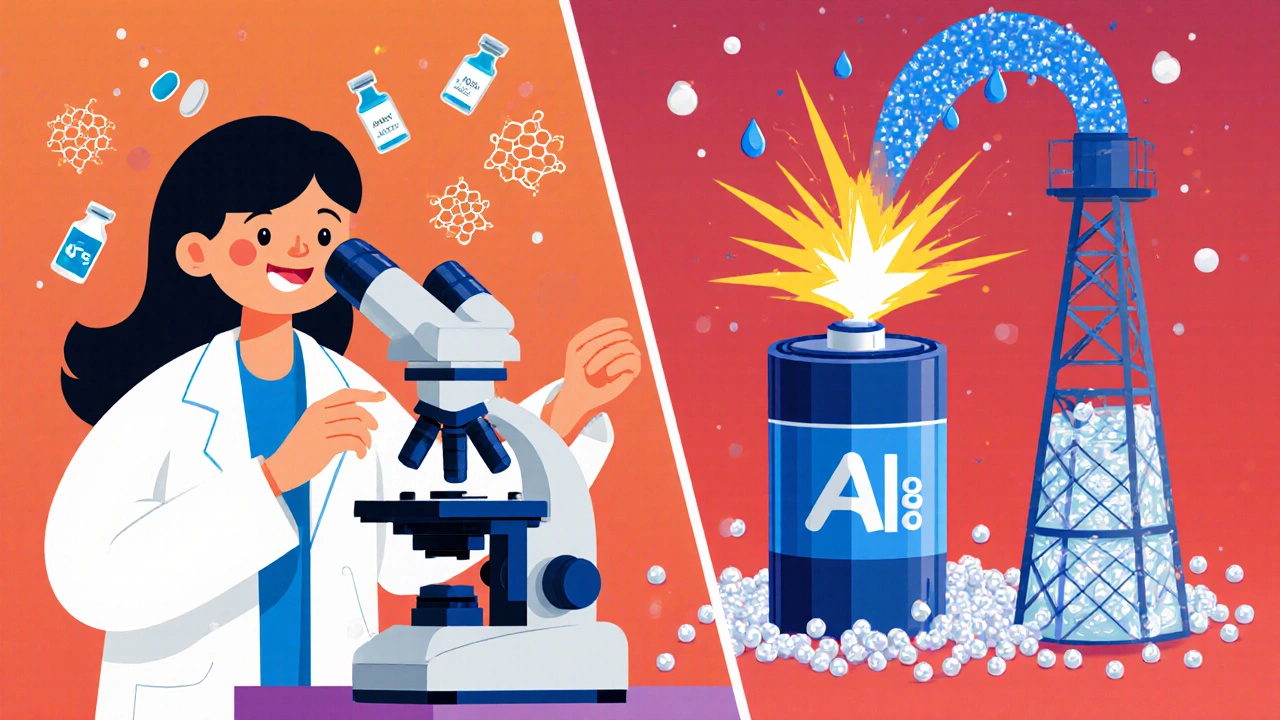
Phosphorus Removal Calculator
Aluminium Hydroxide Water Treatment Calculator
Estimate phosphorus removal efficiency using aluminium hydroxide. Based on industry data showing >95% removal at pH 7 (with efficiency decreasing as pH moves away from neutral).
Results
When you hear aluminium hydroxide, you probably picture an over‑the‑counter antacid or the white powder that helps vaccines work. But that’s just the tip of the iceberg. Scientists are re‑imagining this humble compound for clean energy, water treatment, and next‑generation drug delivery. Below is a deep dive into where the material lives today, the breakthroughs on the horizon, and what those changes could mean for patients, engineers, and the planet.
What Exactly Is Aluminium Hydroxide?
Aluminium hydroxide is a white, sparingly soluble inorganic compound with the formula Al(OH)3. It forms a gelatinous precipitate in water and can exist as a crystalline or amorphous solid depending on processing conditions. Historically discovered in the early 19th century, it gained fame for its ability to neutralize stomach acid and, later, as a safe, inexpensive adjuvant in human vaccines. Its layered structure-alternating Al‑O and hydroxide sheets-gives it a high surface area, making it a versatile platform for chemical reactions, ion exchange, and particle coating.
Current Core Uses
Three sectors dominate aluminium hydroxide consumption today:
- Pharmaceutical adjuvant: The World Health Organization estimates that more than 70 % of all licensed vaccines contain aluminium‑based adjuvants, most of which are aluminium hydroxide. Its ability to form a depot at the injection site enhances antigen presentation, boosting immune response without adding significant toxicity.
- Antacid: Over‑the‑counter preparations like Maalox and Mylanta rely on the compound’s ability to neutralize excess gastric acid, providing quick relief for heartburn and dyspepsia.
- Flame retardant: In polymer composites, aluminium hydroxide releases water vapor when heated, slowing flame spread. It’s a preferred halogen‑free alternative in electronics housings and vehicle interiors.
Emerging Medical Trends
Beyond traditional vaccines, researchers are leveraging aluminium hydroxide’s surface chemistry for more targeted therapies.
- Vaccine adjuvant engineering: By nano‑structuring the hydroxide particles, scientists can modulate the size‑dependent immune pathways, creating adjuvants that skew toward Th1 or Th2 responses as needed for diseases like malaria or cancer.
- Nanoparticle drug carriers: Coating biocompatible nanoparticles with a thin aluminium hydroxide shell improves stability in the bloodstream and enables pH‑triggered release in acidic tumor microenvironments.
- Oral vaccine platforms: Aluminium hydroxide’s muco‑adhesive properties facilitate antigen uptake across the gut lining, opening the door to needle‑free immunizations for rotavirus or COVID‑19.
Regulators such as the FDA have already granted investigational new drug (IND) status for several aluminium‑hydroxide‑based nanocarriers, signaling growing confidence in safety profiles.

Energy and Environmental Innovations
The rise of renewable energy has sparked interest in aluminium hydroxide as a functional material for batteries and water treatment.
| Sector | Key Role | Impact Metric (2024) | Major Players |
|---|---|---|---|
| Pharmaceuticals | Adjuvant & drug carrier | ~2 billion doses annually | GlaxoSmithKline, Sanofi |
| Energy Storage | Battery cathode additive | 10 % boost in specific energy for Li‑ion cells | Tesla, CATL |
| Water Purification | Phosphate adsorption | Removal of >95 % PO₄³⁻ at pH 7 | Veolia, Suez |
| Flame Retardancy | Halogen‑free fire suppression | Reduced peak heat release rate by 30 % | DuPont, BASF |
In battery research, aluminium hydroxide is being transformed into a high‑capacity Battery cathode material. When calcined to form γ‑Al₂O₃, it serves as a scaffold for lithium‑rich oxides, enhancing conductivity while mitigating dendrite formation.
For water treatment, the hydroxide’s positively charged surface attracts negatively charged phosphate ions, a leading cause of eutrophication. Pilot plants in the Netherlands and Singapore reported cost‑effective phosphorus recovery rates exceeding 90 % using aluminium‑hydroxide‑based sorbents.
Industrial Advances and Materials Science
Manufacturers are tapping into the compound’s fire‑safety and mechanical reinforcement properties.
- Nanocomposites: Dispersing nano‑aluminium hydroxide into thermoplastic polymers raises the material’s tensile strength by up to 15 % while retaining low weight, ideal for aerospace interiors.
- 3D printing: Researchers have formulated printable inks where aluminium hydroxide particles act as both a rheology modifier and a post‑print flame‑retardant, enabling rapid prototyping of safe consumer electronics.
- Solid‑state electrolyte: When combined with lithium‑phosphate glasses, aluminium hydroxide contributes to ionic conductivity values above 10⁻⁴ S cm⁻¹ at room temperature, a critical threshold for next‑generation solid‑state batteries.
European standards bodies, notably the European Medicines Agency, are already reviewing data packages for aluminium‑hydroxide‑based medical devices, suggesting a smoother path for cross‑border commercialization.

Regulatory Landscape and Safety Considerations
Safety remains a central concern, especially as the material migrates from well‑studied antacid markets into novel nanotechnologies.
- Biocompatibility: Chronic exposure studies in rodents show no significant organ toxicity at doses up to 100 mg kg⁻¹ day⁻¹, aligning with the acceptable daily intake set by the FDA.
- Environmental impact: When used in water treatment, the spent aluminium hydroxide sludge can be safely landfilled or recycled into construction aggregates, minimizing ecological footprints.
- Regulatory pathways: The United States classifies aluminium hydroxide as GRAS (Generally Recognized As Safe) for oral use, while the European Union lists it under the Cosmetic Regulation (EC) No 1223/2009 for topical applications.
Manufacturers aiming for the fast‑track Breakthrough Therapy designation for aluminium‑hydroxide‑based vaccines must submit comprehensive particle‑size distribution data, as the FDA now requires nanomaterial characterization for all adjuvant claims.
Future Outlook and Research Directions
Looking ahead to 2030 and beyond, five research thrusts stand out:
- Precision adjuvant design: Machine‑learning models that predict immune signatures from particle morphology could let scientists tailor aluminium‑hydroxide formulations for specific pathogens.
- Hybrid energy materials: Combining aluminium hydroxide with transition‑metal sulfides may unlock high‑energy‑density cathodes for electric‑aircraft.
- Closed‑loop water cycles: Integrating aluminium‑hydroxide sorbents into municipal wastewater plants could turn phosphorus waste into valuable fertilizer, creating a circular economy.
- Biodegradable composites: Embedding the compound in bio‑based polymers could produce fully recyclable, flame‑retardant packaging.
- Regulatory harmonization: International consensus on nanomaterial safety testing will accelerate global rollout of next‑generation aluminium‑hydroxide therapies.
The convergence of material science, immunology, and sustainability suggests that aluminium hydroxide will shift from a “supporting player” to a “strategic platform” across multiple industries.
Key Takeaways
- Aluminium hydroxide’s layered structure gives it a high surface area, enabling diverse functions from vaccine adjuvancy to ion adsorption.
- Current markets (pharma, antacids, flame retardants) already account for billions in annual revenue.
- Emerging applications-battery cathodes, water purification, nanomedicine-are moving from lab to pilot scale, driven by sustainability goals.
- Regulatory bodies are adapting to the nanotech era, but safety data remains a critical gatekeeper.
- Future research focuses on precision design, hybrid energy systems, and circular‑economy models.
Is aluminium hydroxide safe for use in vaccines?
Yes. Decades of clinical data show that aluminium hydroxide, when used at approved doses, causes only mild, transient side effects such as soreness at the injection site. Regulatory agencies worldwide, including the FDA and EMA, consider it safe for routine immunizations.
Can aluminium hydroxide replace traditional antacids?
It already does. Over‑the‑counter products like Maalox and Gaviscon rely on its ability to neutralize excess stomach acid quickly. The compound is inexpensive, has a well‑known safety profile, and works within minutes.
How does aluminium hydroxide improve battery performance?
When calcined to form γ‑Al₂O₃, it acts as a scaffold for lithium‑rich active materials, increasing electronic conductivity and reducing dendrite growth. Early pilots report a 10 % boost in specific energy for lithium‑ion cells.
Is aluminium hydroxide environmentally friendly?
Yes, especially when used in water treatment. The spent sorbent can be regenerated or repurposed as a construction additive, creating a low‑impact waste stream. Its production also avoids halogenated chemicals, reducing overall ecological footprints.
What are the biggest challenges facing new aluminium hydroxide applications?
Key hurdles include scaling nanostructured production without compromising uniformity, meeting stringent regulatory requirements for novel medical uses, and integrating the material into existing manufacturing lines for energy or water sectors.
Comments (7)
-
Chirag Muthoo October 21, 2025
While the overview of aluminium hydroxide applications is comprehensive, it remains essential to acknowledge the incremental nature of these advances; each step must be validated through rigorous peer‑reviewed studies.
Optimistically, the convergence of pharmaceutical and environmental research may yield synergistic benefits that merit continued investment.
-
Harry Bhullar October 30, 2025
Indeed, the multifaceted role of aluminium hydroxide warrants a detailed exploration beyond the cursory summary provided. Starting with its historical use as an antacid, one appreciates how its amphoteric chemistry laid the groundwork for later adjuvant applications in immunology. The adjuvant function, relying on depot formation and sustained antigen release, has been refined through nano‑structuring techniques that manipulate particle geometry to steer immune polarization toward Th1 or Th2 pathways, a nuance critical for diseases such as malaria and certain cancers. Moreover, the incorporation of aluminium hydroxide shells onto biodegradable polymeric cores has demonstrably enhanced colloidal stability in the bloodstream, thereby reducing premature clearance and enabling pH‑responsive drug release within the acidic tumor microenvironment. In the realm of energy storage, calcination to γ‑Al₂O₃ provides a high‑surface‑area scaffold that supports lithium‑rich cathode materials, leading to measurable improvements in specific energy and cycle life, as observed in recent pilot studies conducted by major battery manufacturers. Parallel to this, the material’s strong affinity for phosphate ions under neutral pH conditions facilitates efficient phosphorus capture in municipal wastewater treatment, a process that not only mitigates eutrophication but also recovers a valuable nutrient for agricultural use. From a manufacturing perspective, the integration of nano‑aluminium hydroxide into thermoplastic matrices has yielded composites with enhanced tensile strength and flame retardancy, meeting stringent aerospace standards without incurring significant weight penalties. The 3‑D printing sector has also benefited, as inks formulated with fine aluminium hydroxide particles serve both as rheology modifiers and post‑print fire suppressants, enabling rapid prototyping of safer consumer electronics. Regulatory pathways, while evolving, have begun to accommodate these novel uses; the FDA’s recent guidance on nanomaterial characterization for adjuvants exemplifies the shifting landscape. However, challenges remain, particularly regarding the scalability of uniform nanostructure production and the establishment of robust long‑term safety data for chronic exposure scenarios. Collaborative efforts across academia, industry, and governmental agencies will be pivotal in addressing these gaps, ensuring that the material’s promise is realized responsibly. Ultimately, the strategic deployment of aluminium hydroxide across medicine, energy, and environmental sectors epitomizes the kind of interdisciplinary innovation necessary to confront global sustainability challenges.
-
Dana Yonce November 9, 2025
Aluminium hydroxide really seems like a hidden hero in so many fields 😊
-
Lolita Gaela November 18, 2025
The multifunctionality of Al(OH)₃ derives from its layered hydroxide lattice, which imparts a high specific surface area conducive to both ion exchange mechanisms in aqueous remediation and antigen adsorption dynamics in immunogenic formulations; such physicochemical versatility underpins its emergence as a platform technology across disparate industrial domains.
-
Giusto Madison November 27, 2025
Listen, the hype around aluminium hydroxide isn’t just marketing fluff-its nanostructured variants actually boost vaccine efficacy, so if you’re still doubting, you’re missing the point. Keep an eye on the data and you’ll see why the field is moving fast.
-
erica fenty December 7, 2025
Exactly!; the kinetic profiles of Al‑based adjuvants show rapid depot formation; and the downstream immune activation aligns with current immunotherapy paradigms.
-
Xavier Lusky December 16, 2025
All this talk about aluminium hydroxide being a miracle material overlooks the fact that large corporations and government labs have been quietly steering research funding to lock us into a single supply chain, limiting competition and keeping the true environmental costs hidden.
